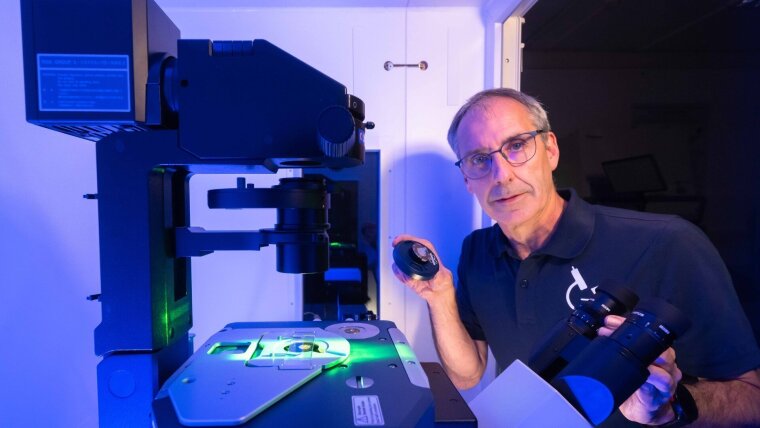
Published: | By: Stephan Laudien
Source article
Earthquakes unleash tremendous forces capable of causing massive destruction. For a long time, seismologists have endeavoured to predict earthquakes, localize them precisely, and explore what exactly is happening within the Earth. Would it perhaps be possible to apply non-destructive methods used in exploring the Earth's interior to minuscule structures? Could the tools of earthquake researchers be used to peek into living cells? How might tremors be generated within cells, and how could these vibrations be utilized? And finally, what would be the benefit of it all?
This seemingly curious idea was hatched by brothers Volker and Hagen Deckert in collaboration with Boris Mizaikoff. "Over a good glass of wine, we came up with this idea," says Volker Deckert. The 58-year-old is the elder of the two brothers. He is a professor of nanospectroscopy at the Institute of Physical Chemistry at Friedrich Schiller University Jena; his brother Hagen is a geologist and heads the Institute for Geothermal Resource Management within the nonprofit ITB gGmbH in Mainz. Professor Boris Mizaikoff leads the Institute of Analytical and Bioanalytical Chemistry at the University of Ulm and is institute director at Hahn-Schickard.
In principle, it is feasible, says Volker Deckert. Whether it is indeed a viable idea will be explored by the trio in the next two years. As part of the Carl Zeiss Foundation's "CZS Wildcard" programme, the researchers will receive 750,000 euros in funding for their project "Geoscientifically inspired, molecule-specific 3D depth analysis with nanometre resolution".
Triggering mini-quakes with ultra-short infrared light pulses
The three researchers aim to fire infrared light pulses into the cell, thereby triggering molecule-specific mini- or, more precisely, nano-quakes without damaging the cell. Similar to "real" earthquakes, waves from these nano-quakes propagate to the surface, where they can be recorded sensitively at multiple measuring points. Using mathematical methods, it should be possible to create a 3D analysis of the cell's interior.
"If everything works out, we could use a cell sample to investigate where a virus docks within the cell," says Volker Deckert. Or it might be possible to determine precisely where a drug exerts its effect. Ultrafine measuring devices and an undisturbed environment would be necessary, but in principle, it should work, says Professor Deckert optimistically. Firstly, the appropriate reference methods need to be developed and the idea tested.
Illustrating the own idea in a comic strip
For the "Wildcard" funding from the Carl Zeiss Foundation, the idea initially had to be explained briefly and succinctly using a comic strip, followed by an oral presentation in which the candidates had to present their projects in direct competition. After the presentation, the jurors and the respective competitors voted.
The next step is to test the idea in practice. As Prof. Deckert explains, staff will be recruited both in Jena and at the other two project locations. The practical implementation experiment will begin next year. The two-year project period is a good time frame to answer the question of whether these "nano-quakes" in the cell can indeed be usefully evaluated in the future.
The "CZS Wildcard" funding programme was launched in 2022. In the second funding round, five research teams were able to convince the expert jury to support them. The aim is to create space for "wild" ideas in the STEM field and support ideas with high innovation potential. The Carl Zeiss Foundation emphasizes that interdisciplinary consortia of three scientists with radically new and daring projects are eligible for funding.
About the Carl Zeiss Foundation
The Carl Zeiss Foundation is committed to creating scope for scientific breakthroughs. As a partner of excellent science, it supports basic research as well as applied research and teaching in the STEM disciplines (mathematics, computer science, natural sciences and technology). Founded in 1889 by the physicist and mathematician Ernst Abbe, the Carl Zeiss Foundation is one of the oldest and largest private science-promoting foundations in Germany. It is the sole owner of Carl Zeiss AG and SCHOTT AG. Its projects are financed from the dividends distributed by the two foundation companies.